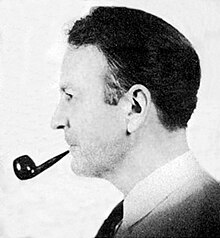
Back Raymond Chandler AN رايموند تشاندلر Arabic رايموند تشاندلر ARZ Raymond Chandler AST Reymond Çandler Azerbaijani ریموند چندلر AZB Raimonds Čandleris BAT-SMG Реймънд Чандлър Bulgarian রেমন্ড চ্যান্ডলার Bengali/Bangla Raymond Chandler Breton
Raymond Chandler | |
|---|---|
 Chandler c. 1943 | |
| Born | Raymond Thornton Chandler July 23, 1888 Chicago, Illinois, U.S. |
| Died | March 26, 1959 (aged 70) San Diego, California, U.S. |
| Resting place | Mount Hope Cemetery, San Diego, U.S. |
| Occupation |
|
| Nationality | American (1888–1907, 1956–1959) British (1907–1959) |
| Education | Dulwich College |
| Period | 1933–1959 |
| Genre | Crime fiction, suspense, hardboiled |
| Spouse |
Cissy Pascal
(m. 1924; died 1954) |
Raymond Thornton Chandler (July 23, 1888 – March 26, 1959) was an American-British novelist and screenwriter. In 1932, at the age of forty-four, Chandler became a detective fiction writer after losing his job as an oil company executive during the Great Depression. His first short story, "Blackmailers Don't Shoot", was published in 1933 in Black Mask, a popular pulp magazine. His first novel, The Big Sleep, was published in 1939. In addition to his short stories, Chandler published seven novels during his lifetime (an eighth, in progress at the time of his death, was completed by Robert B. Parker). All but Playback have been made into motion pictures, some more than once. In the year before his death, he was elected president of the Mystery Writers of America.[1]
Chandler had an immense stylistic influence on American popular literature. He is a founder of the hardboiled school of detective fiction, along with Dashiell Hammett, James M. Cain and other Black Mask writers. The protagonist of his novels, Philip Marlowe, like Hammett's Sam Spade, is considered by some to be synonymous with "private detective". Both were played in films by Humphrey Bogart, whom many consider to be the quintessential Marlowe.
The Big Sleep placed second on the Crime Writers Association poll of the 100 best crime novels; Farewell, My Lovely (1940), The Lady in the Lake (1943) and The Long Goodbye (1953) also made the list.[2] The latter novel was praised in an anthology of American crime stories as "arguably the first book since Hammett's The Glass Key, published more than twenty years earlier, to qualify as a serious and significant mainstream novel that just happened to possess elements of mystery". Chandler was also a perceptive critic of detective fiction; his "The Simple Art of Murder" is the canonical essay in the field.[3][4] In it he wrote: "Down these mean streets a man must go who is not himself mean, who is neither tarnished nor afraid. The detective must be a complete man and a common man and yet an unusual man. He must be, to use a rather weathered phrase, a man of honor—by instinct, by inevitability, without thought of it, and certainly without saying it. He must be the best man in his world and a good enough man for any world."[5]
Parker wrote that, with Marlowe, "Chandler seems to have created the culminating American hero: wised up, hopeful, thoughtful, adventurous, sentimental, cynical and rebellious—an innocent who knows better, a Romantic who is tough enough to sustain Romanticism in a world that has seen the eternal footman hold its coat and snicker. Living at the end of the Far West, where the American dream ran out of room, no hero has ever been more congruent with his landscape. Chandler had the right hero in the right place, and engaged him in the consideration of good and evil at precisely the time when our central certainty of good no longer held."[6]
- ^ Chandler 1950, "About the Author".
- ^ "Crime Writers Association - Top 100 Crime Novels of All Time". August 19, 2012.
- ^ "Sheffield Hallam Working Papers: The Thirties Now". extra.shu.ac.uk. Retrieved May 2, 2022.
- ^ Pronzini & Adrian 1995, p. 169.
- ^ Chandler, Raymond (December 1944). "The Simple Art of Murder". The Atlantic.
- ^ Parker, Robert B. (October 8, 1995). "The Big Text". The New York Times.